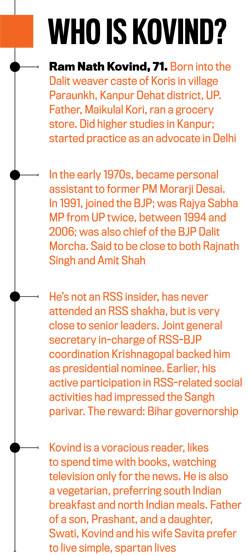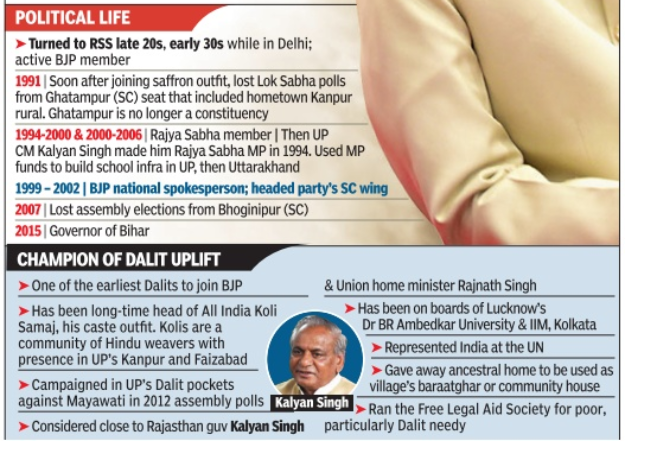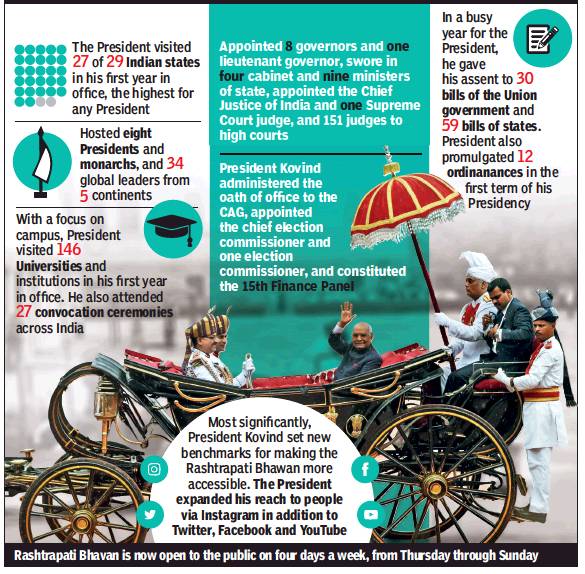Ram Nath Kovind
(→Ram NathKovind, the 14th President of India) |
(→Ram Nath Kovind, the 14th President of India) |
||
| (One intermediate revision by one user not shown) | |||
| Line 38: | Line 38: | ||
10. On August 8, 2015, Kovind was appointed governor of Bihar. | 10. On August 8, 2015, Kovind was appointed governor of Bihar. | ||
| − | =Ram | + | =Ram Nath Kovind, the 14th President of India= |
[http://epaperbeta.timesofindia.com/Article.aspx?eid=31808&articlexml=THE-14TH-PRESIDENT-21072017016058 THE 14TH PRESIDENT|Jul 21 2017 : The Times of India (Delhi)] | [http://epaperbeta.timesofindia.com/Article.aspx?eid=31808&articlexml=THE-14TH-PRESIDENT-21072017016058 THE 14TH PRESIDENT|Jul 21 2017 : The Times of India (Delhi)] | ||
[[File:ram 2.png|Ram NathKovind, the 14th President of India.jpg| Ram NathKovind, the 14th President of India<br/>From [http://epaperbeta.timesofindia.com/Article.aspx?eid=31808&articlexml=THE-14TH-PRESIDENT-21072017016058 '' The Times of India ''] |frame|500px]] | [[File:ram 2.png|Ram NathKovind, the 14th President of India.jpg| Ram NathKovind, the 14th President of India<br/>From [http://epaperbeta.timesofindia.com/Article.aspx?eid=31808&articlexml=THE-14TH-PRESIDENT-21072017016058 '' The Times of India ''] |frame|500px]] | ||
[[File:ram1.png|Ram NathKovind, the 14th President of India.jpg| Ram NathKovind, the 14th President of India<br/>From [http://epaperbeta.timesofindia.com/Article.aspx?eid=31808&articlexml=THE-14TH-PRESIDENT-21072017016058 '' The Times of India ''] |frame|500px]] | [[File:ram1.png|Ram NathKovind, the 14th President of India.jpg| Ram NathKovind, the 14th President of India<br/>From [http://epaperbeta.timesofindia.com/Article.aspx?eid=31808&articlexml=THE-14TH-PRESIDENT-21072017016058 '' The Times of India ''] |frame|500px]] | ||
| − | [[File: What made him special .jpg| What made him special https://www.indiatoday.in/magazine/nation/story/20170703-ram-nath-kovind-president-dalit-modi-bjp-opposition-986668-2017-06-24 .<br/>“India Today”|frame|500px]] | + | [[File: What made him special .jpg| What made him special [https://www.indiatoday.in/magazine/nation/story/20170703-ram-nath-kovind-president-dalit-modi-bjp-opposition-986668-2017-06-24 .<br/>“India Today”]|frame|500px]] |
=Career= | =Career= | ||
Latest revision as of 10:46, 20 February 2019
This is a collection of articles archived for the excellence of their content. |
Contents |
[edit] Brief biography

“India Today”
Here are ten facts about the Dalit leader:
1. Kovind was born October 1, 1945 at Kanpur Dehat in Uttar Pradesh.
2. He has Bachelor's degrees in Commerce and Law, both from Kanpur University.
3. The Dalit leader became a Rajya Sabha MP in April 1994 from Uttar Pradesh and served for two consecutive terms for 12 years until March 2006.
4. Kovind is an advocate by profession. He was a central government advocate in the Delhi high court from 1977 to 1979, and Central Government Standing Counsel in the Supreme Court from 1980 to 1993. He became the Advocate-on-Record of the Supreme Court in 1978. He practised in the Delhi high court and the Supreme Court for 16 years until 1993. He enrolled as an Advocate in 1971 with the Bar Council of Delhi.
5. Kovind has served as member on several important Parliamentary Committees. They include: Parliamentary Committee on Welfare of Scheduled Castes/Tribes, Parliamentary Committee on Home Affairs, Parliamentary Committee on Petroleum and Natural Gas, Parliamentary Committee on Social Justice and Empowerment, Parliamentary Committee on Law and Justice. He also chaired the Rajya Sabha House Committee.
6. The Bihar governor is a former president of the BJP Dalit Morcha (1998-2002) and President of the All-India Koli Samaj. He has also served as national spokesperson of the party.
7. Kovind has served as a board member at Dr. B.R Ambedkar University in Lucknow and the Indian Institute of Management in Kolkata.
8. He has represented India in the United Nations and addressed the United Nations General Assembly in October, 2002.
9. Kovind is married and has a son and a daughter.
10. On August 8, 2015, Kovind was appointed governor of Bihar.
[edit] Ram Nath Kovind, the 14th President of India
THE 14TH PRESIDENT|Jul 21 2017 : The Times of India (Delhi)

From The Times of India

From The Times of India

“India Today”
[edit] Career
A lawyer who cracked civils but lost 2 elections |Jun 20 2017 : The Times of India (Delhi)
His appointment as Bihar governor two years ago was as surprising as his selection as the next `probable' President. That's probably because he was not very well known in political circles. But Ram Nath Kovind was one of the first lot of Dalit leaders to join the saffron party.
He was the central government's advocate in the Supreme Court during the Janata Party government and finally joined BJP in 1991 after 16 years of practice. From there to the Raj Bhawan of Bihar and now a likely journey to Rashtrapati Bhawan -it has been a story of dedication and tireless work for the organisation. He even donated his ancestral house in Paraunkh village in Derapur to the R S S. Kovind was a BJP Rajya Sabha member for two consecutive terms from 1994 to 2006.
In between, he was also the BJP Dalit Morcha president between 1998 and 2002.He served as the national spokesperson for the party and also on several impor tant Parliamentary Committees. After pursuing degrees in commerce and law from Kanpur University , he started preparing for the civil services in Delhi. He cracked the examination in 1975 but didn't join as he was selected for the allied services.
After that, he started full-time practice in Delhi high court and the Supreme Court and came in contact with political leaders. He also served as the personal assistant of Morarji Desai in 1977-78 when he was Prime Minister.
Just after he joined BJP, the party fielded him from Ghatampur in UP but he lost. His next attempt at electoral politics was in 2007, when he was fielded from the Bhognipur assembly constituency in UP. He lost again. But the party did recognise Kovind's organisational and administrative skills. Perhaps it was because of his administrative skills that he hardly had any confrontation with Bihar chief minister Nitish Kumar, who had said he had not been consulted before Kovind's appointment as Bihar governor.
His political journey was mainly centred around the rights and uplift of the weaker sections of the society. Apart from being the chief of the BJP's SCST wing, Kovind had joined the SCST employees' movement against the central government in 1997 to protest against some government orders. Later, the orders were termed null and void by the passage of three amendments to the Constitution during the first NDA regime. In Bihar, he was widely acclaimed for constituting a judicial commission to check irregularities in promotion of undeserving teachers, bungling of funds and appointment of undeserving candidates in universities.
[edit] Mentored by Kalyan Singh
Subhash Mishra| A product of Kalyan Singh lab| Jun 24 2017 | The Times of India (Delhi)
Ram Nath Kovind, the NDA presidential candidate, was a product of former Uttar Pradesh chief minister Kalyan Singh's initiative to expand the BJP's base by promoting leaders from the marginalised sections of society.
Before joining BJP in 1990, Kovind practised law and did social work. He worked with first non-Congress PM Morarji Desai, and during that time he met the then foreign minister and Jan Sangh leader Atal Bihari Vajpayee.
After he failed to win his first election on a BJP ticket in 1991, Kovind met Kalyan, who was then the most prominent leader of the saffron party and chief minister of UP. At that time, Kalyan was trying to expand the party's base beyond Brahmins and banias, and was trying to bring marginalised sections, most backwards and Dalits, into BJP.That's why the UP BJP of early 90s is called the “caste laboratory of Kalyan Singh“ which produced leaders like Om Prakash Singh, Ram Prasad Kamal and Hari Narain Rajbhar from the marginalised sections and succeeded in dispelling the notion that the party was a “BrahminBania“ party .
In order to expand the party's base, Kalyan took BJP in rural areas, among farmers, backwards, most backwards and the dalits. Sources said when Kovind met Kalyan, he told him that “you are not the UP assembly material and you rather deserve a Rajya Sabha seat“. And Kalyan sent Kovind to the RS in 1994. He was re-nominated in 2000 and remained in the Upper House for 12 years, though he never won an election.
[edit] Presidency
[edit] 2017-18

From: July 26, 2018: The Times of India
See graphic
President Ram Nath Kovind contributions as President, 2017-18
[edit] Political ideology: Quotas for SC/ ST/ OBC
In a speech on December 17, 2004, Kovind had said reservations over 50-odd years had led to bitterness between reserved castes (SCsSTs OBCs) and general castes, and “both are justified“. He said SCsSTs were concerned that their share of 22.5% in jobs was not filled in decades as the administration of quotas was in the hands of non-reserved castes. On the other hand, he said the non-reserved castes were “also justified in saying how will reservation, which was to last only 10 or 20 years, continue“?
“If you see it from their perspective, they are justified. They must be thinking... if they (SCs STs) have suffered injustice for centuries, will reservation also continue for centuries. I think both sections of society are justified in their argument.But there is a communication gap. It will be good...if they all sit across the table and find out an amicable solution. After all, you cannot carry on with reservation for years. If you do, it will lead to bitterness in society . But it is also correct if (SCsSTs) don't get reservation and don't attain equality , then what is the use of reservations? This is a ticklish question,“ he had said.
Among Kovind's other thoughts were introducing compulsory voting, limiting the number of parties contesting polls to three, and no recognition to post-poll alliances.
The opposition seems to be making an issue of “pluralism“ by saying Kovind in 2010 publicly opposed SC status for Dalit converts to Christianity and Islam -as recommended by the Rangnath Misra Commission. In 2005, in RS, he sought introduction of SCST quotas in minority institutions, which are exempted.
However, his views on Dalit converts and caste quotas in minority institutions are in line with BJP's stand and also find favour with the Dalit community. The opposition will also highlight that Kovind had testified in favour of disgraced BJP chief Bangaru Laxman who was later convicted for corruption.
[edit] Trivia, anecdotes
[edit] Turned back from President's Shimla home: May 2017
On May 30, Kovind along with his family had returned from the gates of the Retreat.
The President visits the Retreat at least once a year, his core office shifts here during the stay.
The Retreat, located on the hilltop at Mashobra, was built in 1850 and taken over by the British viceroy in 1895.
SHIMLA: Less than a month [before he became the BJP nominee for India’s presidential election], Bihar governor Ram Nath Kovind was not allowed to enter the Retreat, the official residence of the President of India in Shimla. Security personnel had told him that he did not have the requisite permissions from the President's office. And today, Kovind is the BJP-led NDA's nominee+ to become President of India.
It was on May 30 2017 that Kovind along with his family had returned from the gates of the Retreat. The day also happened to be his marriage anniversary.
Kovind had reached Shimla on May 28 and had stayed at the Raj Bhawan as Himachal Pradesh governor Acharya Devvrat is his good friend and both were appointed as governors on the same day. He was there for Devvrat's marriage anniversary on May 29 and Kovind had brought him box of mangoes from Bihar as gift.
The next day, Kovind celebrated his own marriage anniversary. As Kovind did not know what places to visit during his stay, professor Shashikant Sharma, advisor to Himachal Pradesh governor had suggested that he visit the Siog reserve forest and had also told him about the Retreat.
"I had asked him to visit Siog forest area thinking he would not have the time to visit the Retreat but later he went there on his own only to return from the gates," Sharma said. He said that the security personnel could not have known that the person they denied entry to now has the distinct possibility of returning to the same Retreat as the President of India.
The Retreat, located on the hilltop at Mashobra, was built in 1850 and taken over by the British viceroy in 1895. The President visits the Retreat at least once a year and his core office shifts here during the stay. It's a wooden structure with dhajji wall (stone-inlaid quake resistant) construction.
Top Comment
Now don't make a villain out of the Retreat security. He was rightfully doing his duty. Actually a word of praise for the security would have shown a non bias view in the article. / Rahul Barnwal